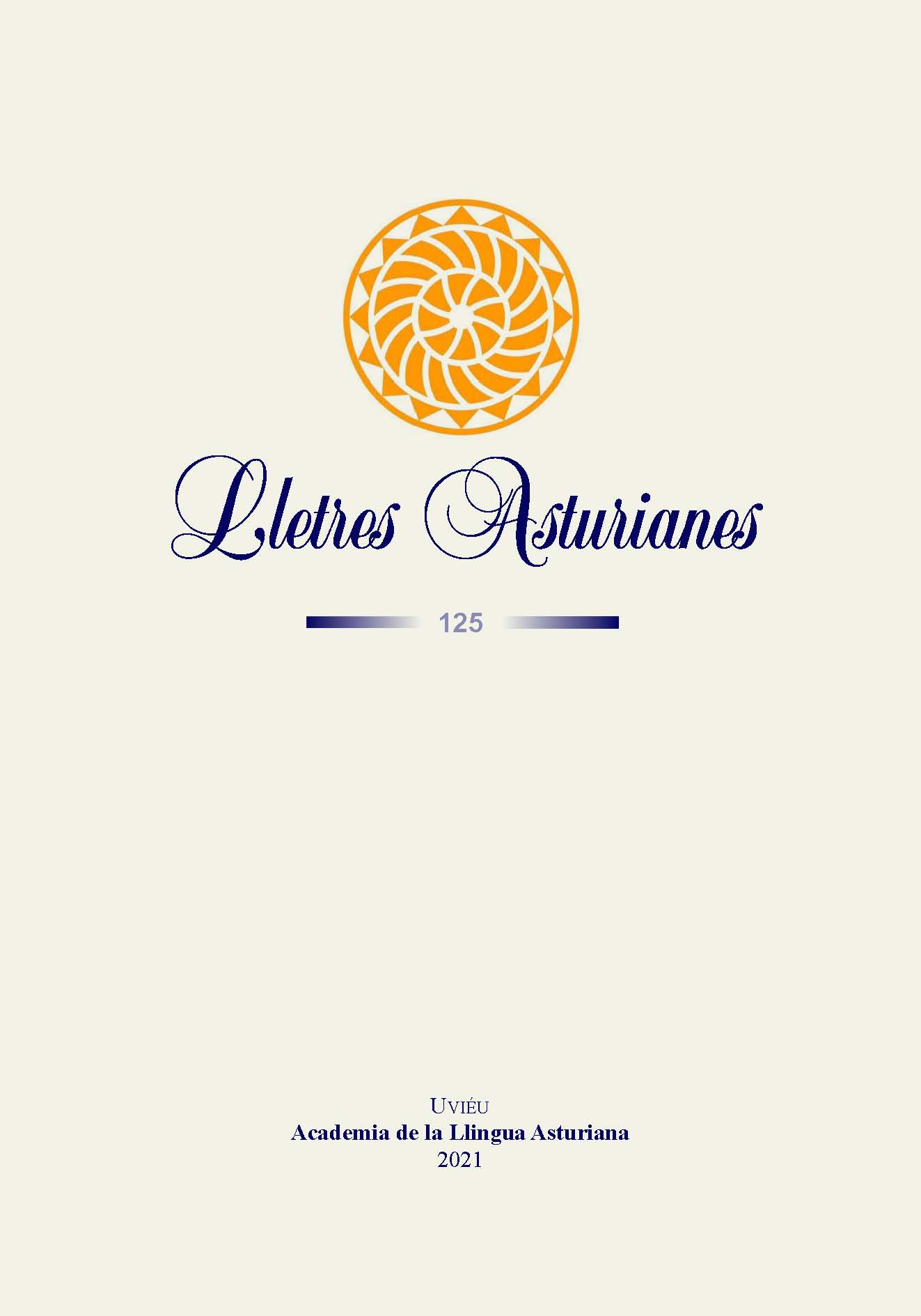Abstract
In the present work we are going to make an approach to the grammaticalization and pragmatization processes that asymmetrically affected the pragmatic modalizers typical of the Asturian language ho(m), ne, nin and nina. Relate to the grammaticalization process, we can see that these items come from lexical units with full meaning, which over time were grammaticalized, undergoing a series of changes at different linguistic levels (phonetic, morphological, semantic ...) until they become the modalizers of today. However, the incidence of grammaticalization did not affect all items in the same way, which is reflected in the different functions and effects of these modalizers. Thus, they replaced the referential load, the ability to send an element of reality, by the instructional load, the ability to provide instructions to decode the message in the most appropriate way when referring to a certain reality. This substitution of the referential (typical of the symbolic sign), by the instructional (typical of the indexical sign) implies a process of pragmatization of these elements. Taking into account that the pragmatic categories constitute a spectrum between two extremes, we are going to deal with two aspects: the first is that according to the degree of grammaticalization, each modalizer will have a character closer to the vocative or closer to the interjection within a spectrum of appeal, without conforming to either of these two categories in an absolute way; the second is that the different degree of grammaticalization will determine the emphasis with which these modalizers value or attenuate statements that may be rude to the interlocutor. And all this within a pragmatic framework, without going to assess or propose grammatical categorizations.
References
Albelda Marco, M. (2005). El refuerzo de la imagen social en la conversación coloquial del español. En D. Bravo (ed.), Cortesía lingüística y comunicativa en español. Categorías conceptuales y aplicaciones a corpus orales y escritos (pp. 93-118). Estocolmo: Dunken.
Anselmo Martins, W. (2015). Semiótica de Charles Peirce: o ícone e a primeiridade. Revista Contemplação, 12, 237-250. [Recuperao de http://fajopa.com/contemplacao/index.php/contemplacao/article/viewFile/93/95].
Academia de la Llingua Asturiana (2001). Gramática de la llingua asturiana. Uviéu: Academia de la Llingua Asturiana.
Academia de la Llingua Asturiana (2015). Diccionariu de la Llingua Asturiana. Uviéu: Academia de la Llingua Asturiana. [Recuperao de http://www.academiadelallingua.com/diccionariu/].
Álvarez Menéndez, A. (2016). Caracterización funcional de la interxección: a propósitu de delles interxecciones del asturianu. En Revista de Filoloxía Asturiana, 16, 9-48. [https://doi.org/10.17811/rfa.16.2016.9-48].
Briz Gómez, A. (1998). El español coloquial en la conversación. Esbozo de pragmática. Barcelona: Ariel.
Bybee, J. (2015). Language change. Cambridge: Cambridge University Press. [Recuperao de https://books.google.es/books?hl=ca&lr=&id=b1mtCAAAQBAJ&oi=fnd&pg=PR15&dq=bybee+mechanism+of+semantic+change+in+grammaticalization&ots=RF3e6YWgC7&sig=O7z50yxiXTFmVmkjPNU4o88OLTE#v=onepage&q=bybee%20mechanism%20of%20semantic%20change%20in%20grammaticalization&f=false].
Cuenca, M. J. (2004). El receptor en el text: el vocatiu. Estudis Romànics, 26, 39-64. [Recuperao de http://revistes.iec.cat/index.php/ER/article/viewFile/38582/49235].
Cuenca, M. J. & Hilferty, J. (1999). Introducción a la lingüística cognitiva. Barcelona: Ariel.
Cueto Vallverdú, N. & López Bobo, M. J. (2003). La interjección. Semántica y pragmática. Madrid: Arco Libros.
Escandell Vidal, M.V. (1996). Introducción a la pragmática. Barcelona: Ariel.
Escandell Vidal, M.V. (2014). La comunicación. Lengua, cognición y sociedad. Madrid: Akal.
García Arias, X. Ll. (2002-2004). Diccionario General de la Lengua Asturiana. Uviéu: Editorial Prensa Asturiana. [Recuperao de https://mas.lne.es/diccionario/].
García Arias, X. Ll. (2003). Gramática histórica de la lengua asturiana. Uviéu: Academia de la Llingua Asturiana.
Gomes Pato, P. R. (2014). Ícone, índice e símbolo, fundamentos para ler e organizar a informação em imagens. En XV Encontro Nacional de Pesquisa em Ciência da Informação – ENANCIB 2014. [Recuperado de https://www.academia.edu/9411958/%c3%8dcone_%c3%8dndice_e_s%c3%8dmbolo_fundamentos_para_ler_e_organizar_a_informa%c3%87%c3%83o_em_imagens].
Grice, P. (1975). Logic and conversation. En P. Cole & J. L. Morgan (eds.), Syntax and Semantics 3: Speech Acts, 3 (pp. 41-58). Academic Press. [Recuperao de https://www.ucl.ac.uk/ls/studypacks/Grice-Logic.pdf].
Heine, B., Claudi, U. & Hünnemeyer, F. (1991). Grammaticalization: A conceptual framework. Chicago: University of Chicago Press.
Jørgensen, A.M. (e.d.). Formas de tratamiento: Los vocativos en el lenguaje juvenil de Madrid, Buenos Aires y Santiago de Chile. Univ. de Bergen. [Recuperao de www.colam.org/as%20formas%20de%20tratamento.pdf].
Koch, P. (2008). Tradiciones discursivas y cambio lingüístico: el ejemplo del tratamiento vuestra merced en español. En J. Kabatek (ed.), Sintaxis histórica del español y cambio lingüístico: Nuevas perspectivas desde las Tradiciones Discursivas (pp. 53-87). Madrid: Iberoamericana-Vervuert.
Leech, G. (1983). Principles of pragmatics. Londres-New York: Routledge-Longman Linguistic Library.
Martelotta, M.E; Votre, S. J. & Cezario, M. M. (1996). Gramaticalização no português do Brasil: uma abordagem funcional. Rio de Janeiro: Universidade Federal de Rio de Janeiro.
Martins Valle, C. R. (2000). Marcadores discursivos: considerações sobre os límites entre a gramaticalizaçao e a discursivização. Working Papers em Linguística, 4(1), 104-113. [doi.org/10.5007/%25x].
Meillet, A. (1912). L’evolution des formes grammaticales. Scientia (Rivista di scienza), 12(26.6), 130-158. [Recuperado de https://www.academia.edu/5124610/A_Meillet_L_%C3%A9volution_des_formes_grammaticales].
Muñiz Cachón, C. (2016). Aspeutos prosódicos y pragmáticos de la partícula ho. Lletres Asturianes, 115, 73-88.
Prieto Entrialgo, C.E. (2015). ¿Cómo ye, ho? Usos y valores de la interxeición ho nel asturianu actual. Lletres Asturianes, 113, 65-86.
Sánchez Vicente, X.X. (2008). Diccionariu Asturianu-Castellanu. Uviéu: Trabe.
Sweetser, E. E. (1988). Grammaticalization and Semantic Bleaching. Berkeley Linguistic Society, 14, 389-404.

